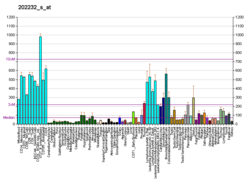| EIF3M | |||||||||||||||||||||||||||||||||||||||||||||||||||
|---|---|---|---|---|---|---|---|---|---|---|---|---|---|---|---|---|---|---|---|---|---|---|---|---|---|---|---|---|---|---|---|---|---|---|---|---|---|---|---|---|---|---|---|---|---|---|---|---|---|---|---|
| |||||||||||||||||||||||||||||||||||||||||||||||||||
| Identifiers | |||||||||||||||||||||||||||||||||||||||||||||||||||
| Aliases | EIF3M , B5, PCID1, TANGO7, hfl-B5, GA17, eukaryotic translation initiation factor 3 subunit M | ||||||||||||||||||||||||||||||||||||||||||||||||||
| External IDs | OMIM: 609641; MGI: 1351744; HomoloGene: 4639; GeneCards: EIF3M; OMA:EIF3M - orthologs | ||||||||||||||||||||||||||||||||||||||||||||||||||
| |||||||||||||||||||||||||||||||||||||||||||||||||||
| |||||||||||||||||||||||||||||||||||||||||||||||||||
| |||||||||||||||||||||||||||||||||||||||||||||||||||
| |||||||||||||||||||||||||||||||||||||||||||||||||||
| |||||||||||||||||||||||||||||||||||||||||||||||||||
| Wikidata | |||||||||||||||||||||||||||||||||||||||||||||||||||
| |||||||||||||||||||||||||||||||||||||||||||||||||||
Eukaryotic translation initiation factor 3, subunit M (eIF3m) also known as PCI domain containing 1 (herpesvirus entry mediator) (PCID1), is a protein that in humans is encoded by the EIF3M gene. [5] [6]
Contents
HFLB5 encodes a broadly expressed protein containing putative membrane fusion domains that acts as a receptor or coreceptor for entry of herpes simplex virus (HSV). [5] [7]





